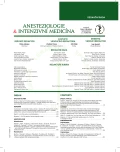Aspiration of gastric contents while using the i-gel laryngeal mask: Case report of three cases
Authors:
T. Henlín 1; P. Derevjaník 1; T. Belšan 2; T. Tyll 1
Authors‘ workplace:
Klinika anesteziologie, resuscitace a intenzivní medicíny, 1. lékařská fakulta Univerzity Karlovy a Ústřední vojenská nemocnice – Vojenská fakultní nemocnice Praha
1; Radiodiagnostické oddělení, Ústřední vojenská nemocnice – Vojenská fakultní nemocnice Praha
2
Published in:
Anest. intenziv. Med., 28, 2017, č. 4, s. 255-259
Category:
Overview
The i-gel supraglottic airway is a second generation supraglottic device, which is used for securing the airway in the operating room and in emergency scenarios. Its functionality and reliability have been proven in many studies. Aspiration of gastric contents is one of the serious complications which are associated with the use of supraglottic airway devices. The incidence of clinically significant aspiration of gastric contents is low and is estimated to be 0.01–0.02%. This article describes three cases of aspiration of gastric contents during the use of the i-gel during general anaesthesia. Obesity probably contributed to aspiration in one patient while in the other cases, impaired gastric emptying and pathological changes in the abdominal cavity were perhaps the cause. All three cases were treated with targeted suction using a flexible bronchoscope. Patients were discharged without further lung injury.
Keywords:
i-gel – aspiration of gastric contents – fibreoptic bronchoscopy
Sources
1. Woodal NM, Cook TM. National census of airway management techniques used for anaesthesia in the UK: first phase of the Fourth National Audit Project at the Royal College of Anaesthetists. Br J Anaesth. 2011;106:266−271.
2. Yu SH, Beirne OR. Laryngeal mask airways have a lower risk of airway complications compared with endotracheal intubation: a systematic review. J Oral Maxillofac Surg. 2010;68:2359−2376.
3. Cook TM, Howes B. Supraglottic airway devices: recent advances. Contin. Educ. Anaesth Crit Care Pain. 2011;11:56−61.
4. Miller DM. A conceptual ideal supraglottic airway. Anest Intenziv Med. 2011;22:149−152.
5. Richez B, Saltel L, Banchereau F, Torrielli R, Cros AM. A new single use supraglottic airway device with a noninflatable cuff and an esophageal vent: an observational study of the i-gel. Anesth Analg. 2008;106:1137−1139.
6. Donaldson W, Abraham A, Deighan M, Michalek P. i-gelTM vs. AuraOnceTM laryngeal mask for general anaesthesia with controlled ventilation in paralyzed patients. Biomed Pap Med Fac Univ Palacky Olomouc Czech Repub. 2011;155:155−163.
7. De Montblanc J, Ruscio L, Mazoit JX, Benhamou D A systematic review and meta-analysis of the i-gel vs laryngeal mask airway in adults. Anaesthesia. 2014;69:1151−1162.
8. Michalek P, Hodgkinson P, Donaldson W. Fiberoptic intubation through an i-gel supraglottic airway in two patients with predicted difficult airway and intellectual disability. Anesth Analg. 2008;106:1501−1504.
9. Kleine-Brueggeney M, Theiler L, Urwyler N, Vogt A, Greif R. Randomized trial comparing the i-gelTM and Magill tracheal tube with the single-use ILMATM and ILMATM tracheal tube for fibreoptic-guided intubation in anaesthetized patients with a predicted difficult airway. Br J Anaesth. 2011;107:251−257.
10. Michalek P, Donaldson W, Vobrubova E, Hakl M. Complications associated with the use of supraglottic airway devices in perioperative medicine. Biomed Res Int. 2015;2015:746560.
11. Nanji GM, Maltby JR. Vomiting and aspiration pneumonitis with the laryngeal mask airway. Can J Anaesth. 1992;39:69−70.
12. Brimacombe JR, Berry A. The incidence of aspiration associated with the laryngeal mask airway: a meta-analysis of published literature. J Clin Anesth. 1995;7:297−305.
13. Cook TM, Lowe JM. An evaluation of the Cobra Perilaryngeal Airway: study halted after two cases of pulmonary aspiration. Anaesthesia. 2005;60:791−796.
14. Koay CK. A case of aspiration using the ProSeal LMA. Anaesth. Intensive Care. 2002;30:391.
15. Gibbison B, Cook TM, Seller C. Case series: protection from aspiration and failure of protection from aspiration with the i-gel airway. Br J Anaesth. 2008;100:415−417.
16. Cook TM, Woodall N, Frerk C and Fourth National Audit Project. Major complications of airway management in the UK: results of the Fourth National Audit Project of the Royal College of Anaesthetists and the Difficult Airway Society. Part 1: Anaesthesia Br J Anaesth. 2011;106:617−631.
17. Bernardini, Natalini G. Risk of pulmonary aspiration with laryngeal mask airway and tracheal intubation: analysis on 65 712 procedures with positive pressure ventilation. Anaesthesia. 2009;64:1289−1294.
18. Robinson M, Davidson A. Aspiration under anaesthesia: risk assessment and decision-making. Cont Educ Anaesth Crit Care Pain. 2014;14:171−175.
Labels
Anaesthesiology, Resuscitation and Inten Intensive Care MedicineArticle was published in
Anaesthesiology and Intensive Care Medicine

2017 Issue 4
Most read in this issue
- Rapid sequence induction in the Czech Republic 2016: Survey
- Aspiration of gastric contents while using the i-gel laryngeal mask: Case report of three cases
- Atrial fibrillation in critically ill patients
-
Preoperative assessment using mobile technologies in the Czech Republic – are our patients ready for it?
Prospective, observational, multicentre, cross-sectional study
